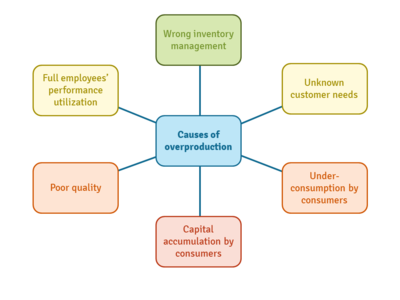Overproduction
| Overproduction |
|---|
| See also |
Overproduction (oversupply) in economics it's an excess of supply over demand. It is more strictly defined in lean manufacturing, where overproduction includes also includes defected products.
In older approach, enterprises treated as overproduction only those products that were not sold to the customers. However this didn't show the real range of overproduction. When the company introduces internal customer concept it treats each next workplace as a customer of earlier one. In that approach more overproduction is revealed. The next step is lean manufacturing which takes into account also those products, which were manufactured with defects and then repaired. Therefore:
The concept of waste in the enterprise is described in articles: 7 wastes of lean and Muda mura muri.
Reducing the amount of overproduction has direct influence on expenses. Fewer raw materials are used, along with less machine time. If the extra goods are stored, reduction in overproduction production will be associated with reduced inventory and its corresponding financial impact.
Forms of overproduction
Overproduction can have two forms:
- Producing more than is required by customers (quantitative type of overproduction).
- Producing products faster than customers are buying them (early type of overproduction).
Causes of overproduction
The main reasons of overproduction are:
- wrong inventory management
- not knowing exactly what the customer wants - production just in case
- desire to utilize full employees performance until end of shift or until finishing raw materials.
- poor quality of products requires manufacturing more in order to fulfil the demand
- changes in the economy (underconsumption)
- changes in consumer behaviour (capital accumulation)
Underconsumption
The underconsumption is related to drop of consumption caused by recession and stagnation. Those economic issues decrease demand and can cause overproduction in the enterprises that use push method of production. Impact of underconsumption on enterprises using pull method of production (e.g. lean manufacturing) will be limited.
Capital accumulation
The underconsumption and then overproduction can be induced also by dynamic that motivates people to limit consumption and put more capital on investments.
Artificial scarcity
Manufacturers can limit production in order to keep prices high. Therefore, they produce less than demand and price can rise. It is only possible in case of monopoly or cartel.
In modern economy the artificial scarcity has also another application. If the producers have ideas that are not shared, they create artificial scarcity. In case of products exchange of them doesn't create additional ones. In case of ideas exchange enables generating multiplication of ideas and than boost the innovativeness.
References
- C.Harris, R. Harris, Developing a lean workforce, Productivity Press, 2007.
- Johnson M.A., Pasour Jr E.C. (1980) An Opportunity Cost View of Fixed Asset Theory and the Overproduction Trap, American Jnl of Agricultural Economics, Volume 63, Issue 1, p. 1-7
- Austenfeld Jr R.B. (2003) A primer on lean enterprise, Hiroshima Shudo University
Author: Joanna Panuś
